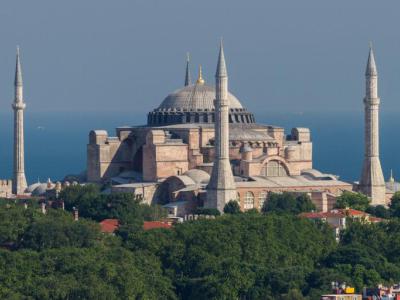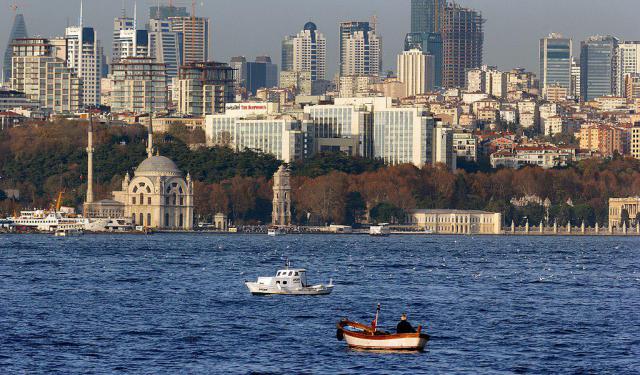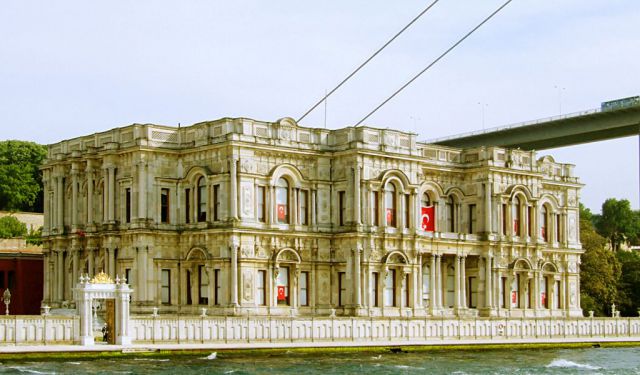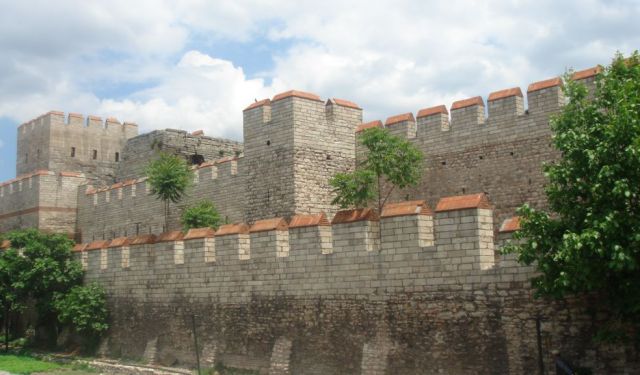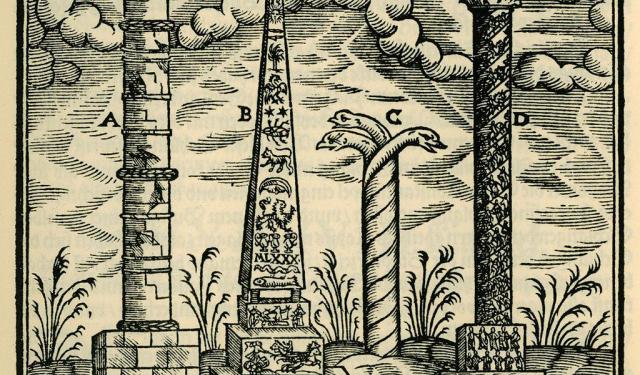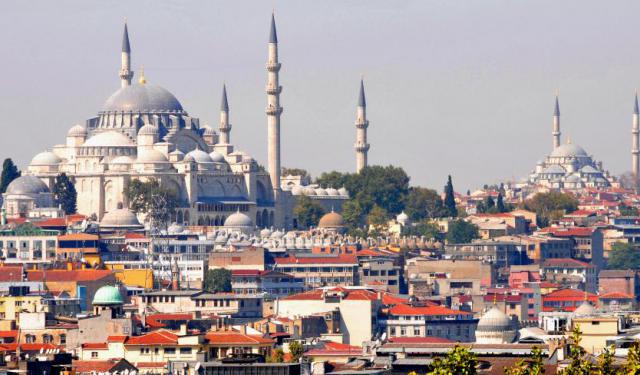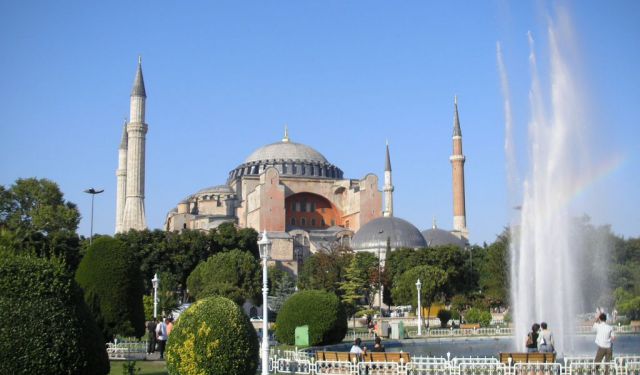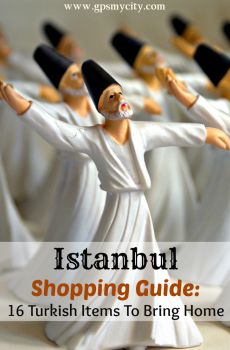Hagia Sophia (Ayasofya), Istanbul (must see)
Hagia Sophia is the ultimate overachiever of both architecture and religion. Built in the 6th century for Emperor Justinian I, it began life as a grand Christian cathedral—basically the power seat of the Eastern Orthodox world. Its giant dome was such an engineering feat that people said it hung from heaven by a chain. At 180 feet tall and 100 feet wide, it still gets a lot of impressed neck-craning today.
Still, history wasn’t satisfied with just one identity for Hagia Sophia. When the Ottomans conquered Constantinople in 1453, Sultan Mehmed II turned it into a mosque. Up went the minarets, out came the church bells, and Christian images were masterly covered—like someone switching décor for a very different house party... Today, you’ll see a fascinating mash-up: Islamic calligraphy panels right beside shimmering mosaics of the Virgin Mary and Jesus. History lesson and cultural fusion rolled into one.
Inside, look for the famous Deësis mosaic from the 13th century, featuring Christ, John the Baptist, and the Virgin Mary, expressing emotion so well it almost feels like they’re watching you back. And don’t miss the “wishing column.” Legend says that if you stick your thumb in the little hole and rotate it just right, you get a miracle. Rumor has it, even Emperor Justinian tried it for headaches—indeed, who needs aspirin when you have ancient architecture?
Recognized as a UNESCO World Heritage Site, Hagia Sophia continues to reinvent itself. After a stretch as a museum, it has returned to its original mission as a place of worship, while its historical displays now live at the nearby Ibrahim Pasha Palace.
Indeed, one shouldn't miss the opportunity to visit here, because where else can you stand in one spot and admire 1,500 years of spiritual remixing? Hagia Sophia’s layers of faith, art, and genius design make it impossible to look away—so go ahead and stare in awe!
Still, history wasn’t satisfied with just one identity for Hagia Sophia. When the Ottomans conquered Constantinople in 1453, Sultan Mehmed II turned it into a mosque. Up went the minarets, out came the church bells, and Christian images were masterly covered—like someone switching décor for a very different house party... Today, you’ll see a fascinating mash-up: Islamic calligraphy panels right beside shimmering mosaics of the Virgin Mary and Jesus. History lesson and cultural fusion rolled into one.
Inside, look for the famous Deësis mosaic from the 13th century, featuring Christ, John the Baptist, and the Virgin Mary, expressing emotion so well it almost feels like they’re watching you back. And don’t miss the “wishing column.” Legend says that if you stick your thumb in the little hole and rotate it just right, you get a miracle. Rumor has it, even Emperor Justinian tried it for headaches—indeed, who needs aspirin when you have ancient architecture?
Recognized as a UNESCO World Heritage Site, Hagia Sophia continues to reinvent itself. After a stretch as a museum, it has returned to its original mission as a place of worship, while its historical displays now live at the nearby Ibrahim Pasha Palace.
Indeed, one shouldn't miss the opportunity to visit here, because where else can you stand in one spot and admire 1,500 years of spiritual remixing? Hagia Sophia’s layers of faith, art, and genius design make it impossible to look away—so go ahead and stare in awe!
Want to visit this sight? Check out these Self-Guided Walking Tours in Istanbul. Alternatively, you can download the mobile app "GPSmyCity: Walks in 1K+ Cities" from Apple App Store or Google Play Store. The app turns your mobile device to a personal tour guide and it works offline, so no data plan is needed when traveling abroad.
Hagia Sophia (Ayasofya) on Map
Sight Name: Hagia Sophia (Ayasofya)
Sight Location: Istanbul, Turkey (See walking tours in Istanbul)
Sight Type: Museum/Gallery
Guide(s) Containing This Sight:
Sight Location: Istanbul, Turkey (See walking tours in Istanbul)
Sight Type: Museum/Gallery
Guide(s) Containing This Sight:
Walking Tours in Istanbul, Turkey
Create Your Own Walk in Istanbul
Creating your own self-guided walk in Istanbul is easy and fun. Choose the city attractions that you want to see and a walk route map will be created just for you. You can even set your hotel as the start point of the walk.
Bosphorus Coast Walking Tour
One of the planet's most praised stretches of water, the Bosphorus is a source of great pride for Istanbulites and of admiration for travelers. The 30-km strait dividing Europe and Asia and connecting the Marmara with the Black Sea is one of the city's highlights, having been for all ages the subject of legend and art.
This self-guided walk will take you along the coast so that you... view more
Tour Duration: 3 Hour(s)
Travel Distance: 5.9 Km or 3.7 Miles
This self-guided walk will take you along the coast so that you... view more
Tour Duration: 3 Hour(s)
Travel Distance: 5.9 Km or 3.7 Miles
Asian Side and Bosphorus Walking Tour
Istanbul is the only megalopolis in the world that straddles two continents. The Bosphorus Strait splits Turkey's biggest city into two parts: European and Asian. The latter, known locally as Asya Yakası (“Asian Side”), or more commonly as Anadolu Yakası (“Anatolian Side”), is found east of the strait, geographically on the Asian mainland.
The vast Anatolian shore, wrongly... view more
Tour Duration: 2 Hour(s)
Travel Distance: 4.6 Km or 2.9 Miles
The vast Anatolian shore, wrongly... view more
Tour Duration: 2 Hour(s)
Travel Distance: 4.6 Km or 2.9 Miles
Istanbul City Walls
One of the most elaborate fortification systems of ancient times, the Walls of Constantinople were built by Constantine the Great to protect the city, the then newly-established capital of the Eastern Roman Empire, from attacks by land and sea. Of these, only the Golden Gate, an old ceremonial gateway into the city, had survived by the late Byzantine Era when a new series of land walls were added... view more
Tour Duration: 2 Hour(s)
Travel Distance: 5.2 Km or 3.2 Miles
Tour Duration: 2 Hour(s)
Travel Distance: 5.2 Km or 3.2 Miles
Byzantine Heritage Walking Tour
Originated as a Greek city called Byzantium, what's now known as Istanbul initially made name as Constantinople, an Eastern Roman imperial capital whose greatness had lasted for over a millennium, from 330 AD until the Ottoman invasion in 1453.
The Byzantine Empire’s rich cultural and architectural heritage is still preserved in dazzling sites throughout the city. Away from its Islamic... view more
Tour Duration: 2 Hour(s)
Travel Distance: 2.5 Km or 1.6 Miles
The Byzantine Empire’s rich cultural and architectural heritage is still preserved in dazzling sites throughout the city. Away from its Islamic... view more
Tour Duration: 2 Hour(s)
Travel Distance: 2.5 Km or 1.6 Miles
Istanbul Old City Walking Tour
The Old City of Istanbul, occupying a triangular peninsula between the Golden Horn and the Sea of Marmara, is one of the most historically layered urban areas in the world. Its evolution reflects a succession of empires that shaped its architecture, culture, and spiritual life. The city’s origins date to around 657 BC, when Greek settlers from Megara founded Byzantium for its ideal harbor and... view more
Tour Duration: 2 Hour(s)
Travel Distance: 2.3 Km or 1.4 Miles
Tour Duration: 2 Hour(s)
Travel Distance: 2.3 Km or 1.4 Miles
Istanbul Introduction Walking Tour
Once called Byzantium, Constantinople, and New Rome, Istanbul has had more name changes over the years than a celebrity avoiding paparazzi... The largest city in Turkey and one of the world’s most historic urban centers, it straddles the Bosphorus Strait like it couldn’t decide whether to sit on its European or Asian side and ultimately opted for both. The result was a cultural smoothie... view more
Tour Duration: 2 Hour(s)
Travel Distance: 4.3 Km or 2.7 Miles
Tour Duration: 2 Hour(s)
Travel Distance: 4.3 Km or 2.7 Miles
Useful Travel Guides for Planning Your Trip
Istanbul Shopping Guide: 16 Turkish Items To Bring Home
Istanbul, known throughout history as Byzantium and Constantinople, has been a major center of commerce and trade, a place where merchants and general folk would rush to regularly in search of exotic things. In our days, modern travelers to Istanbul are also bound to enjoy a truly magnificent...
